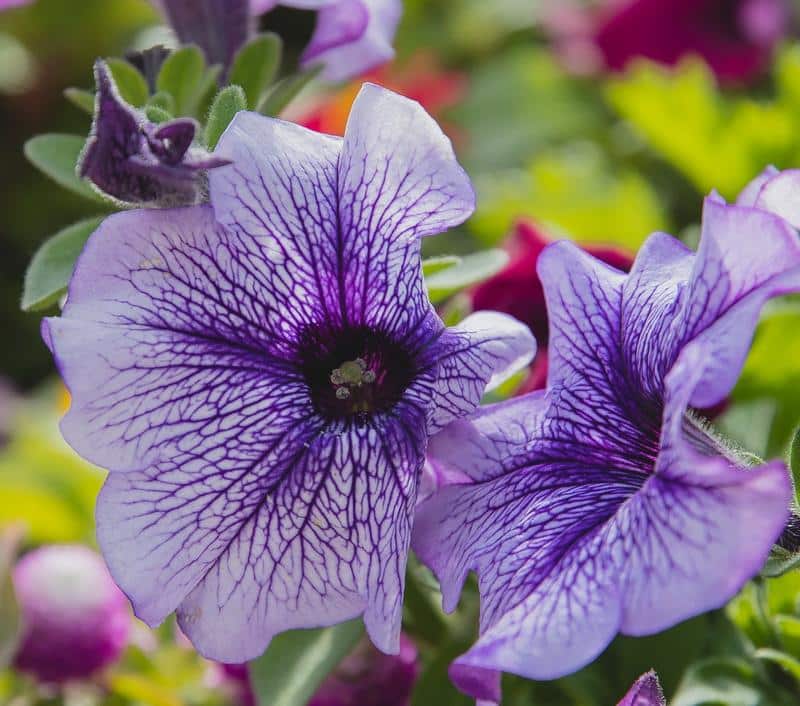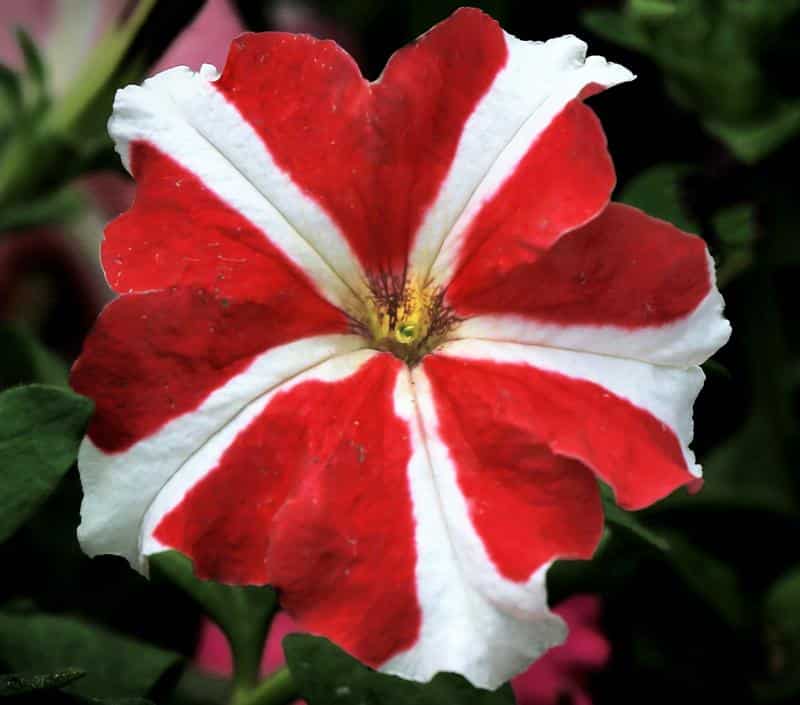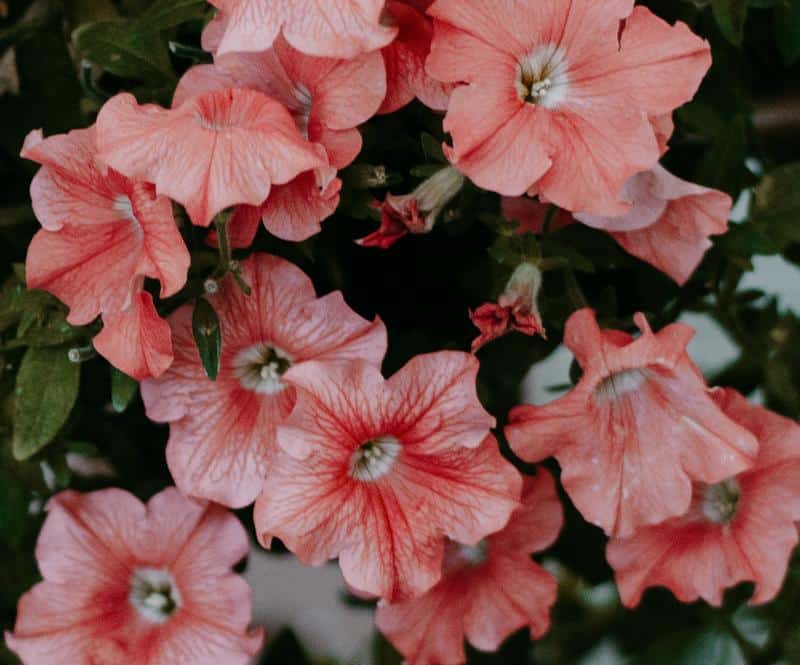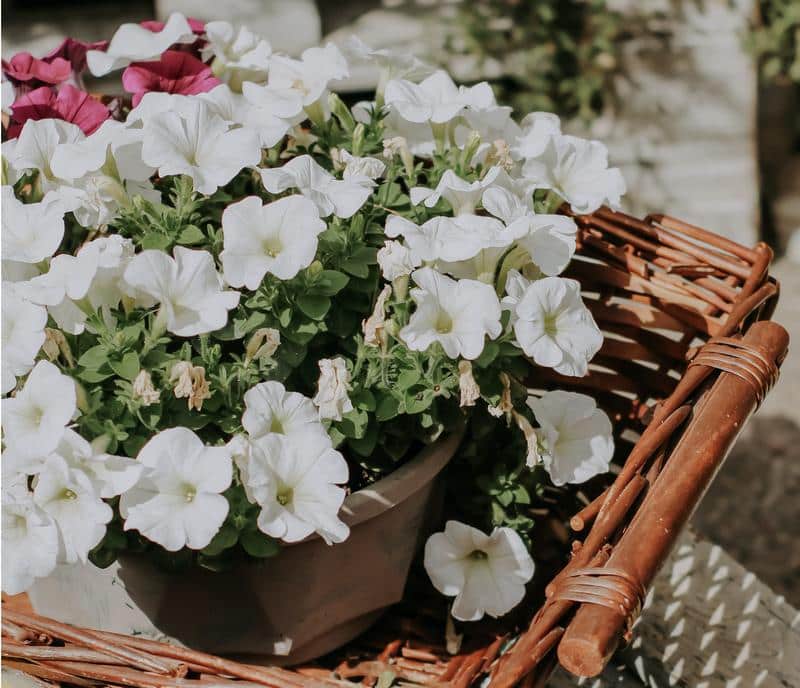Are Petunias Toxic to Dogs? Are Petunias Safe for Dogs?
Are petunias toxic to dogs? Are petunias safe for dogs? In this article, we’ll teach you everything you need to know about if petunias are poisonous to dogs, including what to do if they’ve already eaten some of the plants. We’ll then teach you the two commands you’ll need to be sure that your dog stays away from your petunias in the future.
Next, we’re going to go over more things you should know about petunias and dogs, such as how to keep dogs away from petunias so they can grow to their fullest. Finally, we’ll finish up by instructing you on how to grow petunias with dogs in the home. Keep reading!
Are Petunias Toxic to Dogs?

Petunias are not toxic to dogs. If your dog nibbles on a petunia, it should not be harmful, although non-food plants can cause mild gastrointestinal upset if ingested in large amounts. Therefore, it’s always best to prevent dogs from eating any kind of non-food items, including petunias and other plants.
Are Petunias Poisonous to Dogs?
Petunias are not poisonous to dogs. Despite being non-toxic, it’s still advisable to prevent your dog from eating petunias or any other type of plant material. If consumed in large amounts, they can cause minor gastrointestinal discomfort, such as vomiting or diarrhea.
How to Train “Leave It” Command
Training your dog to understand the “Leave It” command can help prevent them from nibbling on plants and other potentially harmful items. Here’s a brief guide:
- Start with a treat in both hands. Show your dog one hand with the treat and say “Leave it”.
- When your dog stops trying to get the treat and pulls away, reward them with the treat from the other hand.
- Gradually increase the duration before you give the treat as your dog gets better at leaving it.
How to Train “Drop It” Command
The “Drop It” command instructs your dog to let go of an item they’ve picked up. Here’s a quick guide:
- Start by playing a game of fetch or tug with a toy.
- During play, say “Drop It” in a clear, firm voice.
- When your dog releases the toy, reward them with a treat or praise.
- Practice this until your dog drops the toy consistently when commanded.
Petunias are not toxic to dogs, but it’s still best to prevent your dog from eating them or any other plant. These commands will help you do that, but it’s important to remember that the underlying behavioral issues (curiosity, anxiety, boredom, etc.) that were causing all of this to begin with will still be present.
And until you address those, any positive changes you see are only going to be temporary.
“Well, how do I make these changes last?”
By getting your dog to truly choose to follow your direction, that’s how. I tried many times to write out how you can do that before deciding it made more sense to just link you to the free video series that explains it better than I’d ever be able to.
The series is by a man named Dan who is one of the world’s leading dog obedience trainers. In it, he teaches you how to put an end to things like your dog eating petunias and all other misbehavior using his fast and easy-to-follow methods.
In the first video, Dan will reveal to you why the two most common methods of dog training only doom you to failure. You can watch the video now by clicking here. Follow the proven system he’ll show you in his series and you’ll never have to spend another second worrying about your dog eating a petunia ever again!
Are Petunias Safe for Dogs?

Petunias are safe for dogs to eat, as they’re not toxic. However, it’s still best to prevent dogs from eating any non-food items, including petunias. While they aren’t poisonous, they can cause minor gastrointestinal upset if ingested in large amounts.
Can Dogs Eat Petunias?
Petunias are not toxic to dogs, so if your canine companion has a nibble, they are unlikely to suffer from poisoning. That said, petunias and any other non-food items should not be part of a dog’s diet. Regularly eating plants can lead to minor stomach discomfort and should be avoided where possible.
My Dog Ate a Petunia, What Do I Do?
If your dog ate a petunia, don’t panic. These flowers are non-toxic to dogs. However, ingestion of petunias or any other plants can lead to mild gastrointestinal upset, including symptoms like vomiting and diarrhea.
Keep an eye on your dog, and if they show signs of distress or symptoms persist, contact your vet for advice.
Preventing Your Dog from Eating Petunias
To prevent your dog from eating petunias or any other plants, it’s best to supervise them when they’re in a garden or area with accessible plant life. Training your dog to understand commands such as “Leave It” or “Drop It” can be particularly useful to deter them from nibbling on plants. Learn both in the first section.
In conclusion, while petunias are not toxic to dogs, it’s still a good idea to prevent your dog from eating them or any other non-food items. Regularly ingesting plants can lead to minor stomach discomfort.
Always supervise your pet while they’re in an area with accessible plant life and consider training them to understand commands that discourage them from eating non-food items. If your dog eats a petunia and displays symptoms of gastrointestinal upset, don’t hesitate to consult your vet.
You should get this problem fixed now because it will ensure that your dog is always safe around plants in the future. You then won’t have to worry about things like are Mexican petunias poisonous to dogs, are zinnias toxic to dogs, are daffodils toxic to dogs, or are begonias toxic to dogs.
Petunias and Dogs

Petunias are not toxic to dogs. Although they are non-poisonous, it’s still best to prevent dogs from eating them as it can lead to minor gastrointestinal discomfort. This piece will provide tips on how to keep dogs away from petunias and explore more about the relationship between these beautiful flowers and our canine companions.
How to Keep Dogs Away From Petunias
Keeping dogs away from petunias can be achieved through a variety of methods. The use of fencing or barriers can physically prevent dogs from reaching the flowers. Additionally, training your dog to understand commands like “Leave It” and “Drop It” can also be helpful in managing their behavior around plants. Learn both in the first section.
The Appeal of Petunias to Dogs
Like many flowers, petunias can be intriguing to dogs because of their bright colors and the fluttering insects they attract. Understanding this appeal can help in training your dog to avoid them. Distraction with toys or treats, and reinforcing positive behavior can further discourage your dog from disturbing your petunias.
Safe Alternatives for Dogs
If your dog likes to chew on plants, consider providing them with safe alternatives such as dog-friendly chew toys or plants that are safe for dogs to consume. Be sure to research and ensure that any plants you introduce into your dog’s environment are safe and non-toxic.
In conclusion, petunias and dogs can coexist peacefully with the right precautions. Although petunias are not toxic to dogs, preventing your pup from eating these and other flowers can help avoid any potential gastrointestinal discomfort.
Employing strategies such as using barriers, training your dog (learn how in the first section), and providing safe alternatives can ensure both your dog’s safety and the well-being of your garden.
How to Grow Petunias

Growing petunias involves selecting a variety suitable for your climate, planting them in a sunny location with well-draining soil, providing regular watering, feeding with a balanced fertilizer, and occasional pruning for bushy growth and continuous blooming. Petunias, with their vibrant colors and prolonged flowering period, can add a touch of beauty to any garden.
- Choosing the Variety: Petunias come in many varieties, each with unique characteristics. Grandiflora petunias bear large, showy flowers perfect for containers and hanging baskets. Multiflora petunias produce smaller, but more abundant flowers and handle adverse weather better. Wave petunias are excellent ground covers, displaying a profusion of blooms.
- Planting Location: Petunias love the sun, so choose a location that receives at least six hours of sunlight each day. They also prefer well-drained soil. For growing petunias in containers, ensure that the pots have adequate drainage holes.
- Planting Petunias: You can start petunias from seeds indoors 10 to 12 weeks before the last frost, or purchase young plants from a nursery. Plant them in the ground after the danger of frost has passed, spacing them about a foot apart to allow for proper air circulation.
- Watering and Fertilizing: Petunias require regular watering, but avoid waterlogged soil as it can lead to root rot. A balanced, slow-release fertilizer applied every 4 to 6 weeks can support healthy growth and abundant blooming.
- Pruning: To encourage bushy growth and more blooms, pinch off the growing tips of the plants when they are young. Deadhead spent flowers to promote continuous blooming throughout the season.
With a bit of care and attention, growing petunias can be a rewarding gardening experience. Their remarkable colors and profuse blooming can offer a visually stunning addition to your garden, patio, or balcony. Learn to keep your dog away from them by going back to the first section.
I’m sure you’re ready to get all of this behind you so that your petunias and dogs can thrive together, so I’ll let you get started now. Best wishes, and thank you for reading our article “Are Petunias Toxic to Dogs? Are Petunias Safe for Dogs?”





